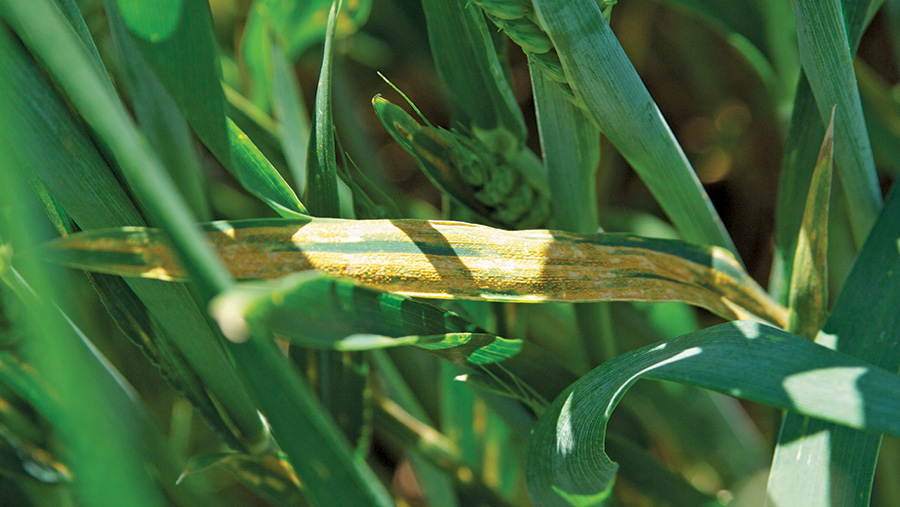Disease alert as yellow rust builds on wheat crops
 © RBI
© RBI Winter wheat crops are under threat from very active yellow rust with a bad disease year now in prospect as the cold snap is only likely to slow its spread.
A mild and wet winter is ideal for the disease’s spread and reports were seen as early as November with some susceptible wheat varieties plastered with the yellow spores.
Bill Clark, technical director at crop consultants Niab, says yellow rust is his biggest concern with the frosty weather not severe enough to control the disease.
See also: How to put a wheat package together to defeat septoria
“Potentially, it could be a very bad year for yellow rust with lots of susceptible varieties and perfect weather the disease’s development,” he tells Farmers Weekly.
Growers are also reporting mildew and septoria in wheat, phoma and light leaf spot in oilseed rape and large number of aphids on many crops.
Levels of yellow rust reached the highest on record in 2014, and with mild weather and aggressive disease strains it looks a safe bet that the disease will be serious this season, says Mr Clark.
He adds the first outbreaks were seen in the susceptible wheat variety Gallant in November while new Warrior races of the disease make it more difficult to control.
In Lincolnshire, Christine Lilly technical manager at agronomy and distribution group Frontier, is seeing sporadic yellow rust on trial sites on moderate to highly susceptible varieties such as Kielder, Solstice and Reflection.
“Growers should be keeping an eye on the disease. Cold weather can knock it back but it can easily start up again,” she says.
David Hoyles, farming in a yellow rust “hot spot” on the edge of The Wash in southern Lincolnshire reports seeing the disease in susceptible varieties.
He has seen the disease in varietal trials on the farm on the moderately susceptible variety Cordiale, but sees his farm varieties, dominated by Evolution, clean at the moment.
His 550ha Monmouth House Farm, at Lutton, east of Spalding, has escaped the worst of the heavy rain seen by many growers which may have helped keep the disease at bay.
Experts say the best control for early yellow rust is to use a cheap azole fungicide such as metconazole or tebuconazole to give a good persistent knock-down effect.
Many growers will be unable to get on rain-soaked fields, so those with yellow rust should monitor fields and may have to treat before the traditional March T0 timing if possible.
Further north, Richard Boldan has never seen mildew as bad as this season on his Energise winter wheat variety, which is proving susceptible to the disease.
Really hope the cold weather arrives as forecast otherwise this Energise is going to need an early fungicide. pic.twitter.com/1gCcinihW8
— Richard Boldan (@RBoldan) January 7, 2016
Farming in East Yorkshire at Box Tree Farm near Howden close to the River Humber he says cold weather now would help control the disease.
“What we need is a week of frosty weather, but it doesn’t look as if we are going to get that,” he says.
Darren Adkins, commercial technical manager at Bayer, is seeing disease levels creeping up in wheat crops in his area of eastern England.
“I’m seeing lots of septoria in wheat on lower leaves which is dangerous because the spores will splash up when it rains,” he says.
Mr Adkins adds there is significant mildew around and some yellow rust is emerging, and some growers are talking of a pre-T0 fungicide spray to knock disease back before it becomes really prevalent.
“If we don’t get some good frosts soon then some crops will be in trouble. We are also seeing aphids active because the current temperatures haven’t been cold enough to finish them off,” he says.
Looking at oilseed rape crops, Tim Bore, research consultant at crop scientists group Adas, says there have been signs of light leaf spot and phoma since mid-November.
“Light leaf spot is set to be very serious this season because of the wet and mild weather, and we will be looking to spray as soon as we can travel,” he says.
On a trial site north of Peterborough, Bayer’s Mr Adkins reports seeing quite a bit of phoma in oilseed rape, especially on the older leaves, although light leaf spot is not evident yet.
https://twitter.com/olihillFW/status/685492374517231616/photo/1
Light leaf spot has taken over from phoma as the most economically-damaging disease of oilseed rape with pale green lesions appearing in the late autumn which then take on a mealy appearance.
Control of the disease is largely based on the use of azole fungicides such as prothioconazole or tebuconazole, or a mixture of the two.
https://twitter.com/11smay/status/684461263120891905/photo/1
Agronomists are also reporting higher level of aphids in crops due to the mild weather putting them at risk from aphid-carrying diseases such as Barley Yellow Dwarf Virus (BYDV) in cereals and Turnip Yellows Virus (TuYV) in oilseed rape.
https://twitter.com/RTKfarmer/status/685239769312395264/photo/1

